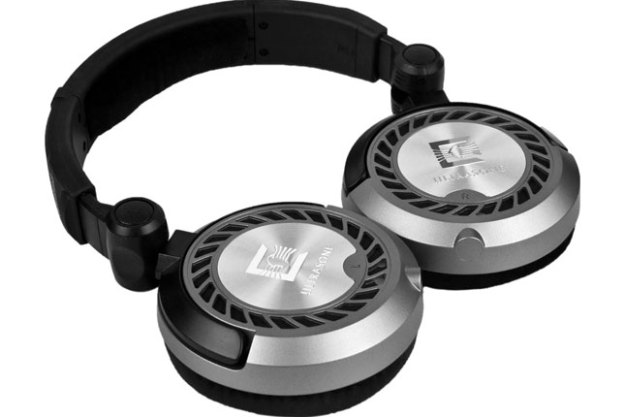
“Move over, Sennheiser. Ultrasone’s HFI-2400 combine the best of German design with a price tag we can live with.”
- Tight, punchy bass
- Very Dynamic
- Solid, high-quality construction
- Extremely comfortable
- Open-backed design doesn’t provide sound isolation
- No 1/8” adapter provided
- Require precise positioning for the best sound

Introduction
Ultrasone is a relative newcomer to the U.S. headphone market. Founded in 1991 and based in Tutzing Germany, Ultrasone has provided the European market with products for the past 19 years. Fortunately for us, the brand is beginning to catch some mainstream attention here in the U.S. and, if they keep making products like the HFI-2400, we think that trend will continue upward. Ultrasone doesn’t tip-toe around the notion that there is more than one German high-end headphone maker (Sennheiser, are your ears burning?) and makes some pretty bold claims as to being “THE German Headphone Company”. In our review of the HFI-2400, we find out if Ultrasone’s bravado translates to hot sound or just a bunch of hot air.
Out of the Box
The HFI-2400 comes with a minimum of packaging fluff. Inside the unassuming box we found the HFI-2400, the headphone’s detachable cable, a demo CD, an instruction manual and a black velvet carrying and storage pouch.
The HFI-2400’s robust construction makes them appear as if they will be fairly heavy but at just 10 ounces (292 grams) the headphones turn out to be reasonably light. The black headband is wide and sturdy with strategically placed padding and oversized hinges that secure it to the individual earphones. The earphones are made of black and grey plastic with a shiny aluminum plate decoratively placed in the center of the earphone’s backing. The inside of the earphone includes foam earpads covered in black velvet cloth.

Features and Design
The HFI-2400
Ultrasone also makes a big deal about their Ultra Low Emission (ULE) electro-magnetic shielding. Apparently, wearing
Ultrasone may lay it on a little thick with the marketing gems but the HFI-2400 really is a well conceived set of
Positioned at the top of Ultrasone’s HFI line, the 2400 have the look and feel of a high-end headphone, but lack some of the accessories that we’ve come to expect from a top-of-the-line offering. Our guess is that Ultrasone has chosen to leave some of these perks out of their HFI line in order to make these ‘phones more affordable and, if that is the case, we applaud them. Those fancy extras are available in the more expensive PRO line for those that will make practical use out of such extras as a hard case, coiled and straight cords and alternate earpad materials. To have the same guts as the more expensive PRO line without the extra cost involved shows careful consideration of the customer’s need and that’s something that we can all appreciate.
Our only complaint about the HFI-2400 is that, at this price level, we still expect to see an audio adapter that allows the HFI-2400’s large ¼” plug to be downsized to suit an iPod, laptop or other portable audio/video device. While this sort of adapter comes cheap at most electronic stores, we hope for something that is on par with the quality of the
 Performance
Performance
Our experience with the HFI-2400 was particularly interesting because, more than any other headphone we’ve tested, the performance of the Ultrasones seemed to change for the better the more we used them. Those that believe strongly in providing a break-in period for all things speaker-related will find that the HFI-2400 benefit a great deal from some pre-evaluation use. Straight out of the box, the high frequency response was extremely hot. It was enough to make us want to remove the HFI-2400 and come back to them later. After about 45 hours of use, however, the HFI-2400’s sound signature changed significantly and for the better.
We love the deep, punchy, super accurate bass response of the HFI-2400’s straight out of the box. While we expected some hearty bass from a headphone of this size, we were pleasantly surprised at how immediate and articulate the 2400’s bass response was. When we listened to Jimmy Smith’s organ on “S Wonderful” from The Sermon we could feel the weight of each key being struck as if we were sitting right next to Jimmy’s leslie speaker. The bass was naturally resonant and never over-bloated as we’ve often heard in other high-end
Fortunately, the Ultrasone’s are not a one trick pony. Many large, over the ear

We tested the HFI-2400 with an iPhone, iPod Touch, Dell Laptop Computer, Onkyo and Harman Kardon receivers and through a HeadRoom DAC and Amp combo. As one would expect: the better the source, the better the sound. But the delta between the good and the bad was more sharply pronounced with the HFI-2400 than almost any headphone we’ve reviewed to date. They hide nothing, so be prepared to hear just how bad (or good) your computer’s sound card or iPod really is.
We have only a few criticisms to offer in regard to the performance of the HFI-2400 by Ultrasone: As open backed
Conclusion
The Ultrasone HFI-2400 sound incredible and, at $299.00, they outperform
Highs:
- Tight, punchy bass
- Very Dyanamic
- Solid, high-quality construction
- Extremely comfortable
Lows:
- Open-backed design doesn’t provide sound isolation
- No 1/8” adapter provided
- Require precise positioning for the best sound
Editors' Recommendations
- The best kids headphones of 2024: for fun, safety, and sound
- Best Beats headphone deals: Studio Pro, Studio Buds, Powerbeats
- Best Apple AirPods alternatives for 2024: Bose, Sony, Marshall, and more
- Beyerdynamic’s DT 770 Pro X offers premium features for less
- Sennheiser Accentum Plus aims at the middle ground between budget and baller






